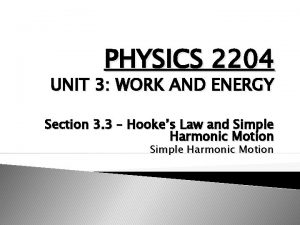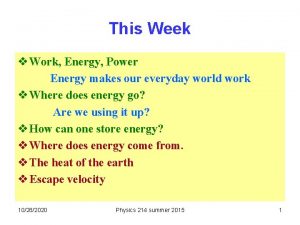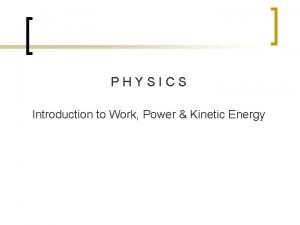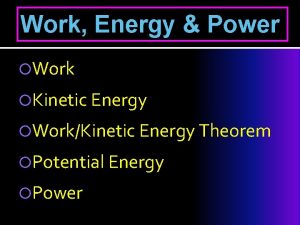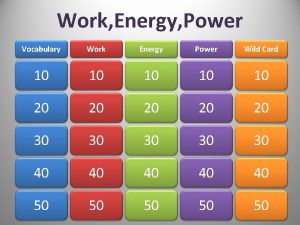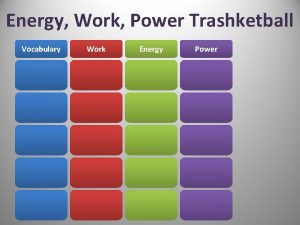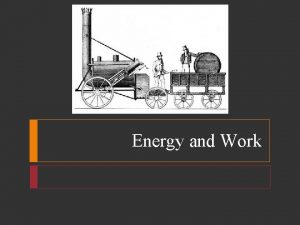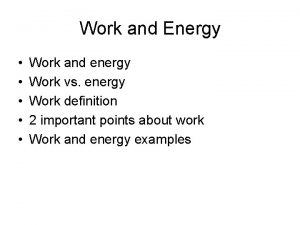Energy Work and Power Physics 1 D 03









- Slides: 9

Energy, Work and Power Physics 1 D 03 - Lecture 22

HOMEWORK QUESTION Please do this question and hand it by Tuesday after the reading week, in class: A 50 kg child slides down a 45 o frictionless hill for 60 m, starting with an initial velocity of 2 m/s. The child then slides for 10 m over a flat surface that has a coefficient of kinetic friction of 0. 15, and finally back up another frictionless hill with a slope of 30 o. Draw a pictures of the problem and determine how far on the 2 nd hill the child ends up (not the height). Physics 1 D 03 - Lecture 22

For every conservative force, we can define a potential energy function U so that WAB = -DU = UA -UB Note the negative Examples: Gravity (uniform g) : Ug = mgy, where y is height Gravity (exact, for two particles, a distance r apart): Ug = - GMm/r, where M and m are the masses Ideal spring: Us = ½ kx 2, where x is the stretch Electrostatic forces (F=kq 1 q 2/r), where q are the charges Physics 1 D 03 - Lecture 22

Conservation of mechanical energy If only conservative forces do work, potential energy is converted into kinetic energy or vice versa, leaving the total constant. Define the mechanical energy E as the sum of kinetic and potential energy: E K + U = K + Ug + Us +. . . Conservative forces only: W = -DU Work-energy theorem: W = DK So, DK+DU = 0; which means that E does not change with time. Physics 1 D 03 - Lecture 22

Example: Pendulum L The pendulum is released from rest with the string horizontal. a) Find the speed at the lowest point (in terms of the length L of the string). vf Physics 1 D 03 - Lecture 22

Example: Pendulum The pendulum is released from rest at an angle θ to the vertical. a) Find the speed at the lowest point (in terms of the length L of the string). θ vf Physics 1 D 03 - Lecture 22

Example You slide 20 m down a frictionless hill with a slope of 30 o starting from rest. At the bottom you collide and stick to another person (at rest) that has 90% of your mass. a) Determine the final velocity of the system. b) How would the calculation and final velocity change if the slope had a coefficient of kinetic friction of 0. 1 ? Physics 1 D 03 - Lecture 22

Power The time rate of doing work is called power. If an external force is applied to an object, and if work is done by this force in a time interval Δt, the average power is defined as: P=W/Δt (unit: J/s = Watt, W) For instantaneous power, we would use the derivative: P=d. W/dt And since W=F. s, d. W/dt=Fds/dt=F. v, so sometimes it is useful to write: P=F. v Physics 1 D 03 - Lecture 22

Example An elevator motor delivers a constant force of 2 x 105 N over a period of 10 s as the elevator moves 20 m. What is the power ? P=W/t =Fs/t =(2 x 105 N)(20 m)/(10 s) =4 x 105 W The same elevator is moving with an average velocity of: The power is: Physics 1 D 03 - Lecture 22



